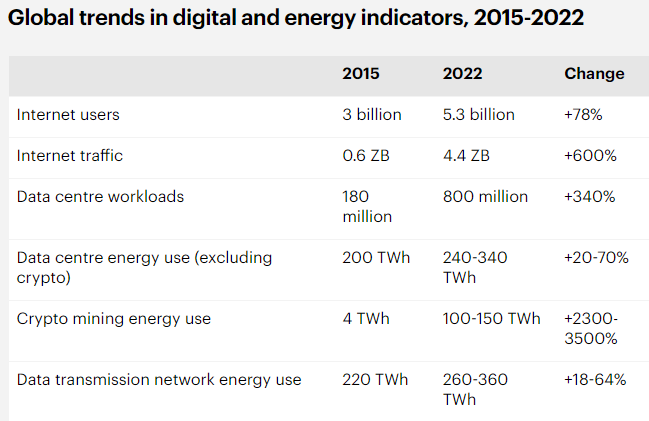You may have heard of the term digital carbon footprint mentioned increasingly these days.
Simply put, digital carbon footprint is a measure of greenhouse gases emissions produced as a result of utilising digital services from web hosting to our handphone devices.
A brand-new smartphone emits an estimated of 85 kg in emissions in the first year of use. A short email you send produces an average of 4g of carbon emissions.
A study done by the carbon emission think-tank, The Shift Project, found that the carbon footprint of producing an iPhone 6 is about 80kg CO2eq and an Apple watch 23 model is 38kg CO2eq.
As our world becomes increasingly digitised, it’s time we pay more attention to the apparent environmental impact of our online activities, especially the websites we visit or build.
There is a direct correlation between digital usage and the amount of carbon emissions as covered later in this article.
The environmental impact of the increasing use of digital media and the digital transition is always underestimated, as devices continue to get smaller and invisible infrastructure remains hidden.
How does technology usage such as scrolling through our Tik Tok feeds or surfing the internet contribute to climate change?
This article provides insights into the question above. It explores the environmental impact of using digital technologies, particularly websites, and how to evaluate and reduce the impact.
Why Your Website Impact The Environment
How your website data is stored and transmitted
Websites are made up of data that is stored and transmitted through various technologies and infrastructure.
When a user visits your website, the website’s data is transmitted from a server to the user’s device through a series of networks, routers, and switches.
The data can be in the form of text, images, videos, and other types of content that make up your website. It is stored on servers, which are specialized computers designed to store and process large amounts of data.

These servers are located in data centers, which are facilities designed to house and manage the servers, as well as the supporting infrastructure such as cooling systems, power supplies, and backup generators.
These data centers can range from small server rooms to large facilities that cover thousands of square meters.
The way your website data is stored and transmitted can have a significant impact on the environmental footprint of a website.
Inefficient data storage methods can lead to increased energy consumption while transmitting data over long distances can result in higher carbon emissions from the use of networks and transportation.
Energy consumption of data centres and data transmission networks
The energy required to power servers and data centres, as well as the manufacturing and maintenance of the hardware and infrastructure of our devices, contribute significantly to carbon emissions and climate change.
In Singapore, data centres accounted for 7% of the total electricity consumption (3.4 TWh) in 2020 and are estimated to grow to 12% by 2030.
In a report by International Energy Agency (IEA) published in September 2022, data centres and data transmission networks each account for 1.0 – 1.5% of global electricity use.

Source: Data Centres and Data Transission Networks, IEA
Carbon emissions associated with website usage
The carbon footprint of the internet is growing daily with an increasing number of users.
The following table indicates the five countries with the highest number of internet users, as well as the country’s contribution to global CO2 emissions.

Source: Top 5 Countries with the Highest Internet Users
This carbon footprint consists of online streaming and downloading, online searches, cloud storage as well as email sending.
Each time we use our phones to access the Internet, we are using energy and emitting greenhouse gases unknowingly.
According to a study published by the carbon emission think-tank, The Shift Project, in March 2019, digital technologies contributed 4% of global greenhouse gas emissions, which is double the aviation industry’s emissions. Its energy consumption is also increasing by 9% a year.
Online streaming services such as Netflix represent 20% of the greenhouse gas emissions of all digital devices.
Every single internet search consumes about 0.3 Wh of energy and contributes 0.2g of CO2 emission. And in the United States, that’s equivalent to about one-third of the average electricity use of a typical household.
Tools to measure your website carbon footprint
There are a variety of tools to measure the carbon footprint of your website.
Bear in mind these tools only provide estimates and actual carbon footprint varies depending on the methodologies and data sources used to calculate.
Here are some of the widely recognized tools that you may use. It is recommended to use different tools to have a more complete picture of your carbon footprint.
GHG Calculation Tools
The GHG Protocol sets out globally standardized frameworks to measure and manage greenhouse gas (GHG) emissions. It was developed by the World Resources Institute (WRI) and the World Business Council for Sustainable Development (WBCSD).
There are different types of calculation tools available on the GHG Protocol website to use.
One such tool is the GHG Emissions Calculation Tool. It is a free, Excel-based tool that gives rough estimates.
Note that the GHG Protocol requires a significant amount of data collection and analysis, so it may not be feasible for all website owners.
Each of the tools also comes with recommendations on how to reduce your carbon footprint.
Website Carbon Calculators
These are online tools that are simple and easy to use for website owners of all levels of technical expertise. Simply enter your website URL to start calculating the carbon footprint.
If you are looking for a quick estimate of your website’s carbon emissions, look no further than these options.
Here are a few examples of website carbon calculators you can use:
- Website Carbon Calculator: By entering your website URL, you can measure the carbon footprint of your website. It calculates the emissions based on page size, server location, and user traffic.
- Ecograder: This tool provides a sustainability score for your website. It assesses the website’s environmental impact based on website size, hosting provider, and user traffic.
- Green Web Checker: This is a tool provided by Green Web Foundation that advocates and supports users to transition to a fossil-free internet. The tool calculates carbon footprint based on the hosting provider and website traffic. Note that some hosting companies need to register into their registry as their hosting does not use static IP which may affect the result.
CO2.js
This is an open-source Javascript library that allows developers to estimate apps, websites, and software emissions.
It can estimate carbon emissions produced by taking an input of data and moving it over the internet. It’s set to run in Node.js server environments, in browsers as well as some serverless and edge compute runtimes.
Based on your needs, you may prefer one tool over the others.
Assess the methods used by each tool to ensure it aligns with your tracking and reduction goals.
The next section explores the factors that can affect the accuracy of the measurements.
Factors affecting the accuracy of measurements

While website carbon calculators can be useful tools for estimating the carbon footprint of a website, there are several factors that can affect the accuracy of the measurements.
i. Methodology
Each website carbon calculator uses a different methodology to calculate carbon emissions, and these methodologies may not be standardized or consistent. This can result in different estimates of carbon emissions for the same website.
ii. Scope
The emissions sources that are included in the calculation can also affect the accuracy of the measurements. For example, some calculators may only include emissions from the data center, while others may also include emissions from user devices and content delivery networks.
iii. Data quality
The accuracy of the measurements also depends on the quality of the data used. For example, if the data on website traffic or server energy consumption is inaccurate, the resulting carbon footprint estimate will also be inaccurate.
It’s important to keep these factors in mind when using websites to calculate the carbon footprint of a website.
Even though these tools may be able to estimate emissions, they might not provide precise or accurate measurements in all cases.
It’s also important to consider the limitations of these tools and to use them in combination with other strategies to reduce the environmental impact of your website.
How to reduce website carbon footprint
The next step after measuring the carbon emissions of your website is to find out how to reduce them.
Reducing your website’s carbon footprint involves a variety of strategies listed below.
1. Reducing website size and complexity
Large website files take longer to load and require more energy to transmit.
Reduce website size and complexity by compressing images and using efficient coding practices to reduce the amount of data that needs to be transmitted.
2. Reducing server energy consumption
Server energy consumption is a major contributor to website carbon emissions.
Reduce server energy consumption by using virtual servers that allow for more efficient use of resources, using energy-efficient hardware and cooling systems, and optimising server performance.
3. Using renewable energy sources

Another effective strategy for reducing website carbon footprint is to use renewable energy sources to power servers and data centers.
This includes using solar or wind power, purchasing renewable energy credits, or partnering with green hosting providers that prioritise renewable energy use.
4. Encouraging users to reduce their own carbon footprint
Provide information and resources on sustainable practices to your internet users.
Encourage your users by promoting energy-efficient devices and behaviors, highlighting the environmental impact of website use, and partnering with other sustainability initiatives to promote broader climate action.
Conclusion
It’s vital that regardless whether as website owners or users, we start to consider the environmental impact of our online activities.
The carbon footprint of websites is a significant and growing environmental concern that most of us easily overlook. As the digital economy expands in the coming years, we need to seek solutions to reduce our digital footprint in order to save our planet.
The good news is that there are already a variety of sustainable strategies and practices to help you measure and reduce your website’s carbon emissions.
Read: 7 Best Sustainable Web Development Practices in 2023
Read: Green Coding: Sustainable Technology for a Greener Future
From website carbon calculators to renewable energy sources and efficient coding practices, you can now take a range of steps to minimise your website’s carbon footprint and promote sustainable practices.
Not only can you reduce the environmental impact, but you also demonstrate your commitment to social responsibility and care for the environment.
By prioritising the sustainability of your website, you can help to build a more sustainable and resilient future for generations to come.
Additional Resources
Here are some websites and organizations that provide more information and tools for reducing website carbon footprint.
- Sustainable Web Design: Sustainable Web Design is a website that provides resources and best practices for designing sustainable websites, including tips for reducing website carbon footprint.
- Green Web Foundation: The Green Web Foundation is a non-profit organisation that provides a database of green web hosts, as well as a carbon calculator that can estimate the carbon footprint of a website and recommend ways to reduce it.
If you are looking for ways to make your website more sustainable, Websparks is here to help you out.
Websparks is a digital company based in Singapore. We provide sustainable web tech solutions with the aim to reduce your digital carbon footprint and promote sustainable technologies.
Contact us to find out how we can help you reduce your digital carbon footprint today.





